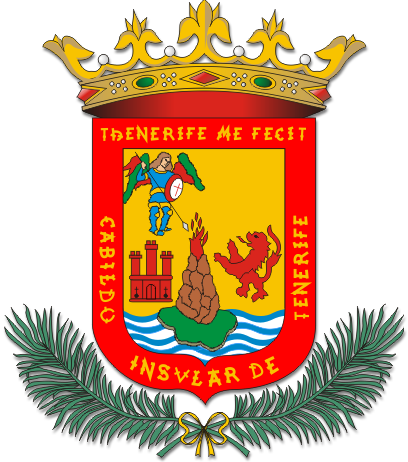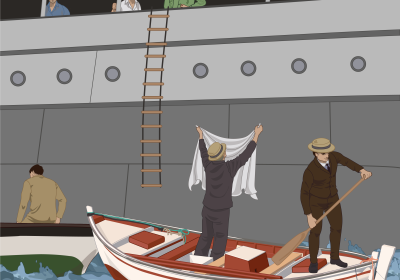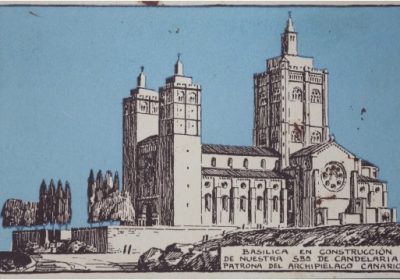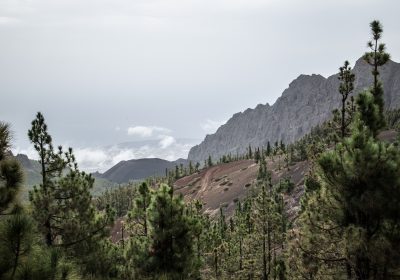I regularly use the heraldic coats of arms of the municipalities of Tenerife in the routes and guided tours, because they tell us the history and customs of each place. I even invite you to look up the coat of arms of each town you visit during your holidays, so that you can get to know a little about each place beforehand.
At first, I used it with groups of children or schoolchildren, as a game to guess what each place tells us about its history, activity, society, etc., until I incorporated it into all the groups because of its dynamics and visuality.
DUPLICITY OF TWO COATS OF ARMS IN TENERIFE
Of the 31 municipal coats of arms in Tenerife, two institutions coincide with the same coat of arms, the town hall of San Cristóbal de La Laguna and the Island Council of Tenerife of 1912. The coat of arms of the historic Council of Tenerife was constituted in 1497 and granted by Queen Juana of Castile by Royal Charter of 23 March 1510. As the city of La Laguna was the capital of the island in the early days after the conquest, it became the emblem of that institution. Centuries later, it became the property of the Town Hall of San Cristóbal de La Laguna due to the disappearance of the Island Council. When in 1912 the institution of the Island Council was recovered in the islands, it took on the same coat of arms of the first Island Council of Tenerife and therefore also of the Town Hall of La Laguna.
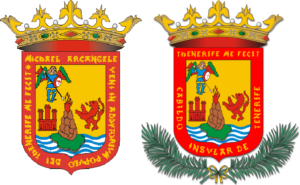
THE CROWNS
Another difference is the type of crown on the upper part of the coat of arms, with 29 coats of arms with a royal crown, one with a marquis’ crown and one with a count’s crown.
Thus, the coat of arms of Adeje has the crown of the marquis and lord of Casafuerte of Adeje and the coat of arms of Santiago del Teide has the crown of the lordship of Valle de Santiago since 1663, under the power of the Hoyo and Solórzano families, which lasted until 1811, when the jurisdictional lordships were incorporated into the nation and the municipality was constituted in 1812 under the protection of the Constitution of Cadiz. It was originally called Valle de Santiago, but due to confusion with the village of the same name on the island of La Gomera, it was renamed Santiago del Teide by Royal Decree on 27 June 1916.


The ancient crown below the royal crown on the coats of arms of Granadilla de Abona and Tacoronte represent the crown of the mencey of Abona and Tacoronte respectively.
Let’s analyse the coats of arms of Tenerife with the different symbols, elements, motifs, signs, badges and emblems that tell their history.
MOTIVES
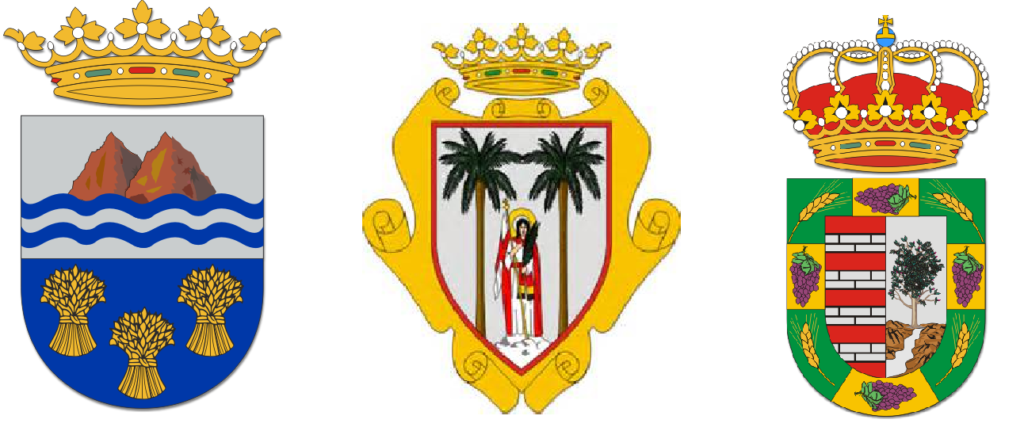
Secular motifs can be seen in the coats of arms of Adeje, La Orotava, Fasnia, El Rosario and Güímar. In the rest of the 26 coats of arms, Christian religious motifs or the cross on the crown can be identified.
GUANCHE SIGNS
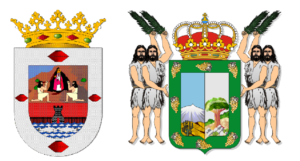
Three coats of arms represent the Guanches, or as the documents of notaries and ecclesiastics say, “Los Naturales”, on the coats of arms of Candelaria, Icod de los Vinos and La Guancha. Another nine contain Guanche utensils such as traditional clay recipients, spears, arms, ruler’s staff, vessels, bowls and a stone circle, which we can find in Adeje, Granadilla de Abona, Guía de Isora, Güímar, La Victoria, La Mantanza, San Miguel de Abona, Santiago del Teide and El Rosario.
SYMBOLS OF THE CASTILIAN CONQUEST
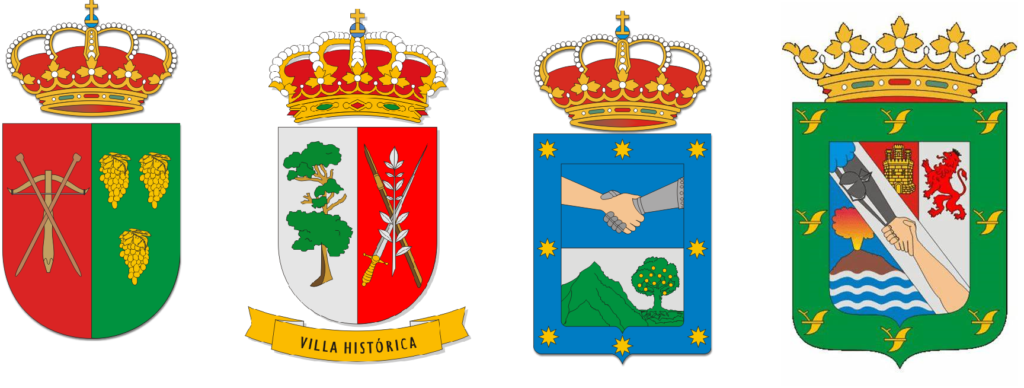
Of the 31 municipalities of Tenerife, eight make direct mention of the conquest of 1496, with Castilian or Guanche elements of episodes from the conquest. Santa Cruz de Tenerife, La Laguna and Los Realejos with crosses, flags and banners. Guía de Isora and Güímar represent the fusion of the two cultures. La Matanza, La Victoria and El Rosario episodes of two battles with different outcomes in the Acentejo ravine.
ETHNOGRAPHIC MOTIFS
There are ethnographic elements such as the traditional earthenware or pottery making in Candelaria, Santiago del Teide and San Miguel de Abona. The historical production of honey on the island, represented by the beehive on the coat of arms of Arico, agricultural activity with the ploughs of Güímar and the fishing tradition of Candelaria.
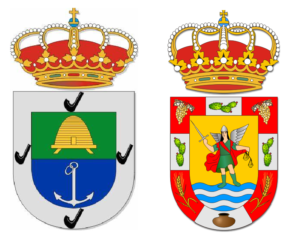
PLANTS, TREES, FRUIT AND ANIMALS
There are representative plant elements of the island, such as the symbolic dragon tree, on the coats of arms of Icod de los Vinos and La Orotava; the fat pine tree of Vilaflor; the almacigo tree on the coats of arms of Guía de Isora and Arona; the cardón euphorbia of Icod de los Vinos, Buenavista and Santiago del Teide; the Canary Island palm tree of Santa Úrsula; the laurisilva in the coat of arms of Tegueste and El Tanque; the Canary Island pine tree in La Victoria, El Rosario and La Guancha; the willow tree in the coat of arms of El Sauzal; the prickly pear cactus in the coat of arms of San Miguel de Abona. Products of the land such as wheat on the coats of arms of Fasnia, El Tanque, Tegueste, San Miguel de Abona and La Guancha.
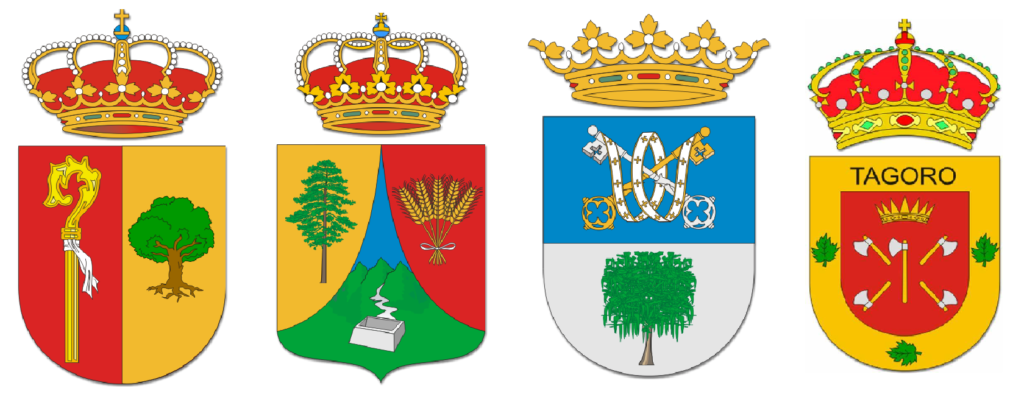
With floral motifs we find the five roses on the coat of arms of El Rosario, vine leaves in Tacoronte, olive branch in La Victoria and palm branch in Icod de los Vinos. With fruit we have 10 coats of arms, pomegranates on the coat of arms of Granadilla de Abona, apples in La Orotava and bunches of grapes from its wine-growing tradition in Arafo, Icod de los Vinos, La Guancha, La Matanza, San Miguel de Abona, Santiago del Teide, Tegueste and Vilaflor de Chasna.

Among the signs representing animals are grasshoppers on the coat of arms of Buenavista del Norte, a reminder that it was saved from a plague of locusts that affected the rest of the island. The lamb of San Juan de La Rambla symbolises Saint John the Baptist. The fish on the coat of arms of Candelaria for its fishing tradition and the cochineal in the prickly pear cacti of San Miguel de Abona. The Lion on the coat of arms of Güímar, San Cristobal de La Laguna, Island Council of Tenerife and Santa Cruz de Tenerife, symbolising the three victories over English naval squadrons. Mythological animals with dragons on the coats of arms of La Orotava and Puerto de La Cruz.

THE WAY OF SANTIAGO IN TENERIFE
The traditional pilgrimage to the sanctuary grotto of Candelaria began after the conquest of the island in 1496. The arrival of the bishop of the Canary Islands, Diego de Muros, after his appointment on 21 July 1496, was one of the few bishops to reside on the islands. Of Galician origin, formerly dean of the cathedral of Santiago, he leaves us with the influence of the pilgrim James the Great, observing the Jacobean portals in the churches of Realejo Alto and Bajo, Garachico, La Orotava, and the one that has disappeared in San Juan de la Rambla.
The patron saints San Cristóbal and San Roque protectors of pilgrims. The tradition of pilgrimage and testamentary mandates to the cathedral of Santiago indicate a strong pilgrimage tradition in Tenerife. Thus, scallop shells can be seen on the coats of arms of Garachico and San Juan de La Rambla; and the Cross of Santiago in Los Realejos, Santiago del Teide and Santa Cruz de Tenerife, the latter in reference to the victory over Horatio Nelson’s squadron.

CASTLES, WALLS, HARBOURS, FOUNTAINS AND LIGHTHOUSES
Castles or fortifications predominate among the constructive elements in the coats of arms of Adeje due to the Casafuerte, Candelaria Castillo de San Pedro and battery of Santiago, Garachico the castle of San Miguel, Güímar symbol of the crown of Castilla y León, Los Realejos the three fortifications that existed in the area, Los Silos the historic keep, San Cristóbal de La Laguna, Santa Cruz de Tenerife and Cabildo Insular de Tenerife. Walls on the coat of arms of Tegueste and a lighthouse on the coat of arms of Buenavista del Norte. Fountains or water springs are located on the coats of arms of Santiago del Teide, El Tanque, La Guancha and Tegueste.
CASTILIAN AND GUANCHE ARMS
The Guanche spear and the Castilian crossbow on the coat of arms of La Matanza de Acentejo. The sword and the spear with olive branch from the coat of arms of La Victoria de Acentejo. The batons in the border of the coat of arms of El Rosario allude to the traditional game of sticks, inherited from the aborigines and currently widely practised in the municipality.
The banner and the ruler’s staff of the coat of arms of Los Realejos allude to the peace between the Castilians and the Guanches signed in the town in the spring of 1496.
The axes of the coat of arms of Tacoronte come from the coat of arms of Sebastián Machado.
OBJECTS, STARS AND SEAS
The lyre on the coat of arms of Arafo stands out for its uniqueness in relation to the musical tradition of the municipality. The key in the coat of arms of Puerto de la Cruz due to its history as the gateway to Tenerife’s trade with Europe and America, after the loss of the port of Garachico in 1706, with the Customs House and consulates. The bright stars of the coat of arms of Guía de Isora; the sun of the coat of arms of Adeje and the ocean or sea of Candelaria, Santa Cruz de Tenerife, San Cristobal de La Laguna, Cabildo Insular de Tenerife, Güímar, Fasnia, Granadilla de Abona, Garachico, San Juan de la Rambla, Puerto de la Cruz, San Miguel de Abona and Adeje.
The crosier of San Antonio Abad in the coat of arms of Arona, and the keys of San Pedro in those of El Sauzal and Vilaflor, or Augustinian symbols in Arafo, founders of the place in the well-known farmhouse of the Augustinians by the date of Añavingo.
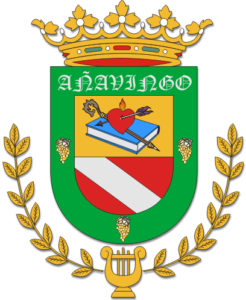
GEOLOGICAL SIGNS
The island of Tenerife on the coats of arms of San Cristobal de La Laguna, Cabildo Insular de Tenerife and Güímar.
The Teide is represented on the coats of arms of Icod de los Vino, Santiago del Teide and La Guancha; Pico Viejo volcano on the coat of arms of Guía de Isora; Trevejo volcano and El Roque in Garachico; El Sombrerito in Vilaflor; Los Roques on the coat of arms of Fasnia, silos for storing cereals on the coat of arms of Los Silos.

BOATS
There is a ship in the coat of arms of Garachico, but the Nao Victoria in the coat of arms of Granadilla de Abona stands out, a ship that anchored in Montaña Roja, before setting off on the round-the-world voyage of Ferdinand Magellan and Juan Sebastián el Cano’s expedition.
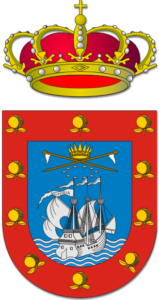
It should be noted that some coats of arms include a word or motto in Spanish or Latin.
NOTES:
1.- JURISCAN database of the Government of the Canary Islands
2.- SÍMBOLOS DE CANARIAS by José Manuel Erbez
3.- LAS PORTADAS JACOBEAS DEL BENEFICIO DE TAORO by Lorenzo Santana Rodríguez
María Mercedes Castellano Fariña
Through this publication, APIT Tenerife echoes the research of its associates and supports the generation of knowledge by its associated tourist guides. However, the opinions expressed by the authors of the articles do NOT reflect in any way the position of the Association. APIT Tenerife is an apolitical, professional and inclusive entity that promotes Canarian heritage of any kind. If you want to contribute elements to the debate on the topics discussed here, we invite you to contact the author whose contact details appear in the signature of the article and in the list of associated guides.

